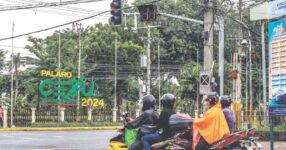
‘Traffic lights not advanced at all’
CEBU City’s “most advanced” traffic light system turned out to be not advanced at all, according to the findings of the experts of the Metropolitan Manila Development Agency (MMDA).
The MMDA findings pointed out that the City’s traffic light system cannot process real-time traffic conditions and there are no safety features for pedestrian crossing.
The MMDA has also made various recommendations, including prioritizing the safety of pedestrians, to improve the efficiency of the modernized traffic lights and signals of the Cebu City Government.
In an endorsement letter of City Councilor Jocelyn Pesquera forwarded to the City Council as part of its agenda for the Sept. 18 regular session, the MMDA provided its “comprehensive technical” report on the City’s traffic system and management after it visited Cebu City last year.
Findings
According to MMDA’s analysis and findings, the City’s traffic signal lights have no safety features for pedestrians, as the sequence for pedestrian green, which means go, coincides with vehicle green, resulting in the crossing pedestrian being caught in the middle of the road, the report added.
Moreover, the report said that the current Command Center is not yet spacious enough to house the Traffic Signal Management System Facilities, as the MMDA recommended establishing an additional space for a server room, locker room, and viewing room for the upcoming construction or the actual Command Center is to be identified.
The Traffic Management Server, the device that controls the traffic signal lights, cannot process real-time traffic conditions collected by the Vehicle Detection Server, nor does it improve the traffic operation efficiency, it also said.
The MMDA discovered that the traffic data collected is for archive purposes only, and the data analysis is done manually, the report said.
The operator also adjusts the timing parameters of the traffic signal system manually rather than automatically.
In terms of synchronization of vehicle movement between intersections, MMDA found out that the main phase of vehicle movement, prioritizing the movement of vehicles on the main road, was misplaced.
MMDA added that the design of the local controller was “non-modular,” in which, at times faulty, the intersection with the signal light had to be shut down instead of modular parts for easier replaceable parts.
With the installation of the license plate recognition camera system, MMDA also said that it can be expanded with more features that will help monitor and implement traffic rules and regulations.
The agency was also provided with an approved budget for the contract that contains items with blank details, while the breakdown of items for each intersection was not reflected.
Recommendation
The MMDA recommended housing the Command Center in a dedicated building that can accommodate servers, personnel with conference rooms, radio rooms, and others.
It also urged the contractor to upgrade the traffic management server to satisfy the terms of reference.
The program must also be modified for the safety of pedestrians, it also pointed out.
The agency further urges maximization of the utilization of the license plate recognition camera system to implement traffic rules and regulations.
The City Government was also urged to coordinate with the contractor to promote easier accessibility to the repair and maintenance of the local controller.
Modern traffic lights
The Cebu City Government first launched in 2020 its P480 million modern traffic signal lights.
It has two phases. The first phase covers 18 intersections on General Maxilom Ave., Serging Osmeña Blvd., and Colon St., among others, for P232 million. It was completed in the last quarter of 2021.
Phase 2 covers 27 intersections and costs P248 million, which, according to Cebu City Transportation Office deputy head and legal officer Kent Francis Jongoy, is not yet completed.
Under its modernization program, the new traffic lights were installed through underground cables and featured 184 high-definition cameras that detect traffic flow using artificial intelligence that automatically adjusts the signal timing.
The cameras installed can capture plate numbers and the persons inside the vehicles. These can zoom in 32 times and can cover 360 degrees.
The supplier was Triune Electronics Systems Inc., a Manila-based technology firm, and Cylix Tech CCTV and Smart Surveillance.
The new system replaced the Sydney Coordinated Adaptive Traffic System, which has been in use for the last 34 years.



